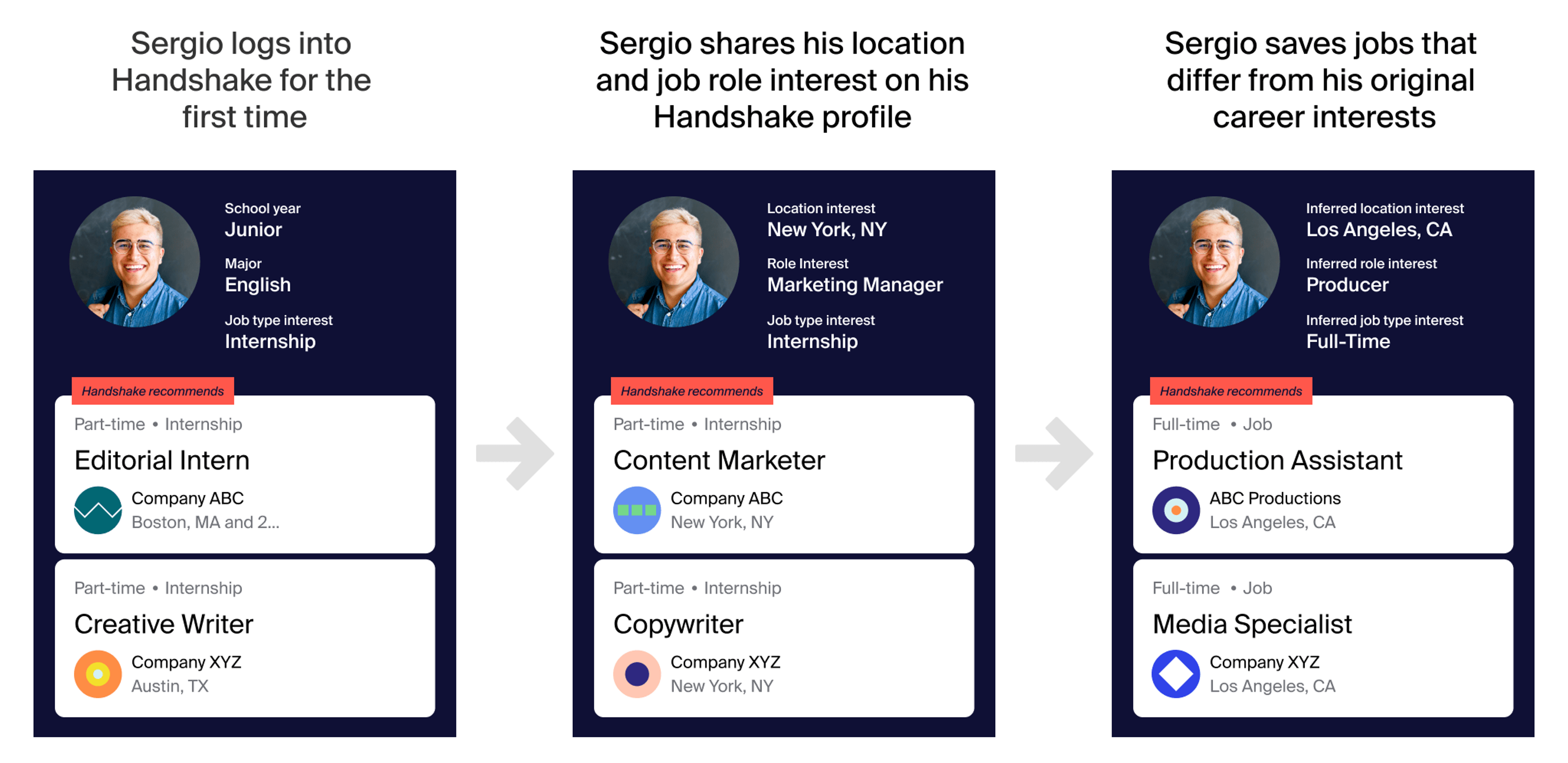Handshake’s long term vision is to increase students’ access to opportunity. As more jobs are available to students, it’s vital that Handshake understands students’ interests and tailors job recommendations to be relevant. In fact, students expect this of us—it’s a precedent set by platforms like Spotify and Tiktok.
While the way we make job recommendations may seem complex, the data we use to inform these recommendations is pretty easy to understand. Read on to learn how we make recommendations and how you should talk to students about approaching their job search on Handshake to be most effective.
What information powers job recommendations?
Handshake looks at three primary buckets of information when developing job recommendations.
- The student’s profile data
- The student’s career interests
- The employers and jobs the student engages with
Each subsequent bucket of data allows Handshake to make progressively better recommendations by providing a more nuanced portrait of what the student wants. For example, we start with basic information, like a student’s major, to make recommendations. But, if the student shares their career interests, we favor career interest related recommendations over major-based recommendations. Let’s discuss why.

How Handshake personalizes job recommendations
Profile data provides a baseline for job recommendations
The most important student profile data is likely imported by your team. A student’s major and school year provide an important foundation for our job recommendations. The student’s major lets us recommend opportunities that other students in that major are uniquely engaging with—and (thanks to major mapping) opportunities that students with a similar major at other institutions are engaging with too. Meanwhile, the student’s school year lets us know whether the student is more likely to be interested in internships or full-time jobs.
Career interests allow students to provide more nuanced input
Once a student logs into Handshake, they can provide additional data points that further hone our job recommendations. The onboarding process prompts students to share key details like job type (part-time, full-time, internship, etc), job role, and location preferences.
Taken together, career interests help us make even more tailored recommendations, giving us a more well-rounded picture of a student than their major alone. As an added bonus, students who share this information are 5x more likely to receive a message from an employer.
The content students engage with on Handshake provides real time insight into their evolving preferences
Students can always update their career interests via their profile. That said, we know they won’t always do it consistently. There are a few ways to ensure we have a regular pulse on students’ interests. First, we prompt students to go through onboarding again at the beginning of the spring and fall terms—we call this “re-onboarding”. This reminds students about how Handshake works and encourages them to update their interests.
Why is the content students engage with on Handshake important? Students still may not update their preferences—they may also not know how to articulate what they’re interested in. Looking at which jobs a student interacts with on Handshake allows us to infer the student’s evolving interests. Every time a student engages with a job or employer on Handshake, we incorporate that information into future recommendations:
- If a student views, favorites, or applies for a job, we show them similar opportunities.
- If a student follows an employer or attends one of their events, we show them relevant opportunities the employer has posted.
This is arguably the most powerful indicator of a student’s interests.
There are a lot of factors to consider when comparing the data powering different job recommendations for students. That said, some head-to-head comparisons exist in the product that can help us illustrate the relative impact. For example, over the last three months, jobs on the homepage recommended based on student activity data had a 70% higher click rate compared to jobs recommended based on job role interests alone.
Understanding how Handshake makes recommendations can help students take a more informed approach to their job search. That said, for the majority of students that log onto Handshake seeking to better understand their options, your advice can be simple—share your interests and start clicking on jobs that catch your eye. Handshake gets smarter the more you use it.
